Burgundy with a Southern Accent II: Côte Chalonnaise’s Ruby Reds and Delicate Whites – Seven Producers in Five Appellations. (7-Bottle Pack $299)
Burgundy with a Southern Accent II: Côte Chalonnaise’s Ruby Reds and Delicate Whites – Seven Producers in Five Appellations.
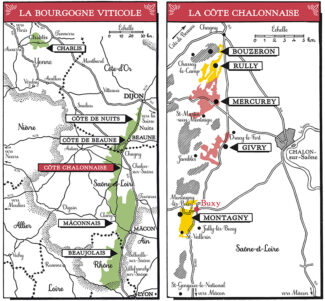 The legend of Snow White and Rose Red may have originated with the Brothers Grimm in Germany, but a modern reenactment can be found in the vineyards of Côte Chalonnaise. In this tale, the star performers are Pinot Noir as Rose Red and as Snow White, Chardonnay. Aligoté is an understudy, except in Bouzeron—the only appellation Village that is entirely produced from this ancient variety.
The legend of Snow White and Rose Red may have originated with the Brothers Grimm in Germany, but a modern reenactment can be found in the vineyards of Côte Chalonnaise. In this tale, the star performers are Pinot Noir as Rose Red and as Snow White, Chardonnay. Aligoté is an understudy, except in Bouzeron—the only appellation Village that is entirely produced from this ancient variety.
Sandwiched between the Côte de Beaune and the rolling hills of the Mâconnais, the Côte Chalonnaise is 16 miles long by four miles wide; the finest vines are planted on southeast slopes and produce red, rosé and white wines from 44 communes within cantons of Buxy, Chagny, Givry and Mont-Saint-Vincent. Like Beaune to the north, the soils of northern Côte Chalonnaise are limestone-dominated with outcrops of lias and trias formations. In the south, the limestone is marly, with sand and flint clays at the foot of the slopes. When graced with long, dry summers, Pinot Noir ripens beautifully, producing wines that (like Rose Red) are sassy, lively and cheerful while Chardonnay, sending roots deep into Burgundy’s clay, is more like Snow White: a homebody, redolent of gentle flowers with a suggestion of warm bread and honey. But in fairness to literary and vinicultural hisotry, Côte Chalonnaise was already staging these heroines half a millennia before the Brothers Grimm penned their first ‘Once upon a time.’
Bouzeron
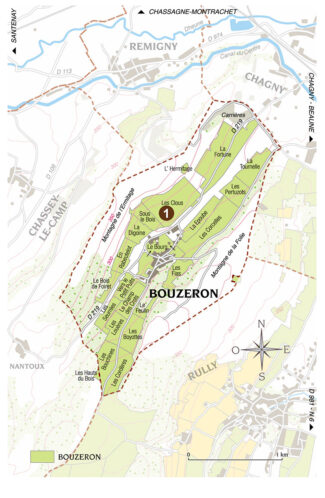 The additional sunshine south of Beaune is what raises Aligoté’s stock value in the Côte Chalonnaise; in Bouzeron especially, the grape turns golden in the long summer growing season and the acidity to sugar balance is better than almost anywhere else in Burgundy. One of the five appellations Villages in the Côte Chalonnaise (and the closest to the Côte-d’Or), Bouzeroncontains no Premier Cru sites, but produces white wines distinct enough to have become virtually synonymous with the ancient varietal Aligoté.
The additional sunshine south of Beaune is what raises Aligoté’s stock value in the Côte Chalonnaise; in Bouzeron especially, the grape turns golden in the long summer growing season and the acidity to sugar balance is better than almost anywhere else in Burgundy. One of the five appellations Villages in the Côte Chalonnaise (and the closest to the Côte-d’Or), Bouzeroncontains no Premier Cru sites, but produces white wines distinct enough to have become virtually synonymous with the ancient varietal Aligoté.
1- Domaine de Villaine
“Chardonnay is not my reference; Aligoté is,” says Villaine owner and winemaker Pierre de Benoist. “My aunt and uncle bought Villaine in 1971, when it was just eight hectares (20 acres). Today we have 21 hectares (52 acres), of which ten are planted to Aligoté.”
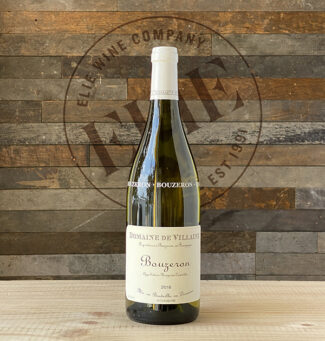 Bouzeron 2018 (White) ($41)is a lovely, nuanced wine with gunflint sparks in the nose along with white flowers and vanilla; the palate opens wide with creamy lemon pudding and honeyed croissant and finishes cleanly.
Bouzeron 2018 (White) ($41)is a lovely, nuanced wine with gunflint sparks in the nose along with white flowers and vanilla; the palate opens wide with creamy lemon pudding and honeyed croissant and finishes cleanly.
Montagny
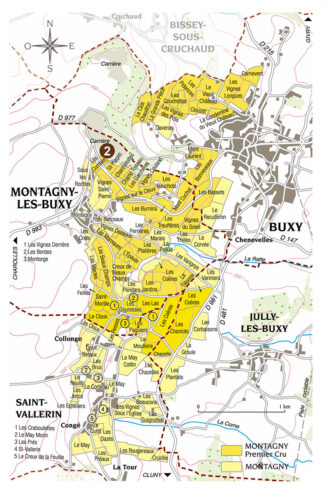 The four villages of Buxy, Montagny-lès-Buxy, Jully-lès-Buxy and Saint-Vallerin form a sort of confederacy on Côte Chalonnaise’s southern tip; Montagny the only one of five Chalonnaise communal appellations devoted exclusively to white wines produced from Chardonnay. High levels of limestone in the local soils impart the highly prized minerality to the wines, but also make them somewhat more acidic. As a result, the juice is often fermented or matured in oak barrels, adding depth and complexity and mellowing the bite.
The four villages of Buxy, Montagny-lès-Buxy, Jully-lès-Buxy and Saint-Vallerin form a sort of confederacy on Côte Chalonnaise’s southern tip; Montagny the only one of five Chalonnaise communal appellations devoted exclusively to white wines produced from Chardonnay. High levels of limestone in the local soils impart the highly prized minerality to the wines, but also make them somewhat more acidic. As a result, the juice is often fermented or matured in oak barrels, adding depth and complexity and mellowing the bite.
2- Domaine du Cellier aux Moines
Headquartered in Givry, Cellier aux Moines is one of the oldest domains in Burgundy. Established by Cistercian monks, it has been surrounded by its Clos for nine centuries. In 2004, the estate was purchased by Philippe and Catherine Pascal; in 2015, Guillaume Marko joined the domain as head of vineyards and winemaking.
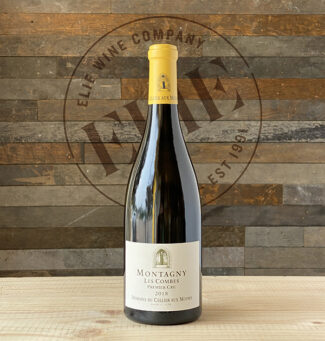 Montagny Premier Cru – Les Combes 2018 (White) ($44). 2018 was an opulent vintage in Montagny, and the wine boasts many white flower aromatic—look for acacia, honeysuckle and lemon-balm. White peach and pear appear in the palate along with an engaging nuttiness adding an earthy edge to the overall delicacy and finesse.
Montagny Premier Cru – Les Combes 2018 (White) ($44). 2018 was an opulent vintage in Montagny, and the wine boasts many white flower aromatic—look for acacia, honeysuckle and lemon-balm. White peach and pear appear in the palate along with an engaging nuttiness adding an earthy edge to the overall delicacy and finesse.
Mercurey
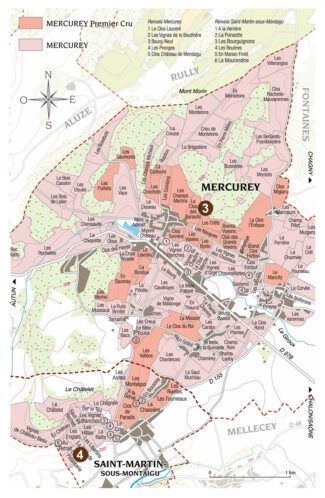 As is the case throughout the wine world, quirks of geology and geography make the appellation. They combine in Mercurey, in the center of the Côte Chalonnaise, to make it one of the premiere growing locations in Burgundy. Tucked away within the ‘Golden Valley’ and its several proximate vales, the vines are protected from damp winds and thrive in marl and calcic soils.
As is the case throughout the wine world, quirks of geology and geography make the appellation. They combine in Mercurey, in the center of the Côte Chalonnaise, to make it one of the premiere growing locations in Burgundy. Tucked away within the ‘Golden Valley’ and its several proximate vales, the vines are protected from damp winds and thrive in marl and calcic soils.
3- Domaine Michel Juillot
Breaking rules in a region where tradition is sacrosanct is a risky venture. Fortunately, shored up by world travels, especially to the new world, Laurent Juillot (Michel’s grandson) returned to Burgundy with notions of how to innovate successfully. Among the changes he brought to the domain was a switch to sustainable agriculture while maintaining a regimen of hand-picking fruit and relying on indigenous yeasts.
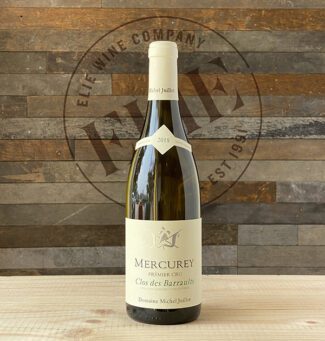 He has excelled in his single-parcel cuvées, especially Mercurey Premier Cru – Clos des Barraults 2018 (White) ($42). Juillot is regarded as a virtuoso of Chardonnay, and this wine is sufficient evidence: It leads with silken, sensuous and subtle scents of apple and spicy peach while the palate displays pineapple and honey with candied lemon on a textured, creamy finish.
He has excelled in his single-parcel cuvées, especially Mercurey Premier Cru – Clos des Barraults 2018 (White) ($42). Juillot is regarded as a virtuoso of Chardonnay, and this wine is sufficient evidence: It leads with silken, sensuous and subtle scents of apple and spicy peach while the palate displays pineapple and honey with candied lemon on a textured, creamy finish.
4- Domaine Philippe Garrey
The wines of vigneron Philippe Garrey have been called profound, and regardless of art form, such a descriptor is the pinnacle of praise. With roots in the southern end of the Mercurey appellation now six-generations deep, Garrey quietly maintains his scant eleven acres entirely alone, and has no wish to expand; like most winemakers, he believes that his wines must express his unique terroir, but also, to ensure that they are equally representative of his family’s name and reputation.
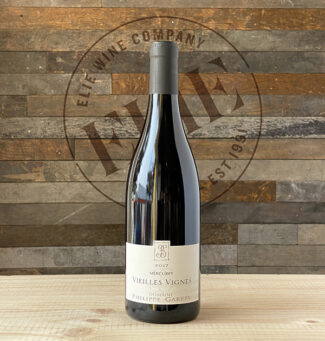 Mercurey ‘Vieilles Vignes’ 2017 (Red) ($39) is a blend of two parcels, one with 80-year-old vines and a second where the vines range from sixty to seventy years of age. An intense purplish-red hue introduces a pungent nose that suggests black cherry and truffles and a silky, broad and layered mouthfeel follows with beautifully integrated tannins.
Mercurey ‘Vieilles Vignes’ 2017 (Red) ($39) is a blend of two parcels, one with 80-year-old vines and a second where the vines range from sixty to seventy years of age. An intense purplish-red hue introduces a pungent nose that suggests black cherry and truffles and a silky, broad and layered mouthfeel follows with beautifully integrated tannins.
Rully
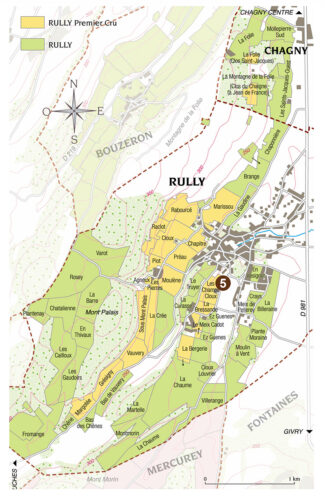 Home to both Pinot Noir-based reds and Chardonnay-based whites, Rully is also the epicenter for the unusual, delightful Crémant de Bourgogne a sparkler made from either (or both) varieties. The wide variety of terroirs contained within the appellation contains ideal cradles for Burgundy’s premiere grapes: To coddle Pinot Noir, it provides lime-rich soils with little clay, and for Chardonnay, clay and limestone mixed. As such, Rully is home to 23 Premier Cru sites and dozens of named, widely acclaimed lieux-dits.
Home to both Pinot Noir-based reds and Chardonnay-based whites, Rully is also the epicenter for the unusual, delightful Crémant de Bourgogne a sparkler made from either (or both) varieties. The wide variety of terroirs contained within the appellation contains ideal cradles for Burgundy’s premiere grapes: To coddle Pinot Noir, it provides lime-rich soils with little clay, and for Chardonnay, clay and limestone mixed. As such, Rully is home to 23 Premier Cru sites and dozens of named, widely acclaimed lieux-dits.
5- Domaine Michel Briday
Michel and Lucette Briday founded this property in 1976 with 15 acres. Today, managed by Michel’s son and daughter-in-law Stéphane and Sandrine, it has grown to 38 acres spread across the municipalities of Rully, Bouzeron, and Mercurey. In defining their vinicultural philosophy, Michel Briday quotes Justin Godard: “In truth no product requires as much varied work, or sustained attention as wine.” In part, this involves adhering to the Terra Vitis charter, which aims to respect the soil, to manage the vineyard in a considered way and have each step of production checked by an approved and independent body.
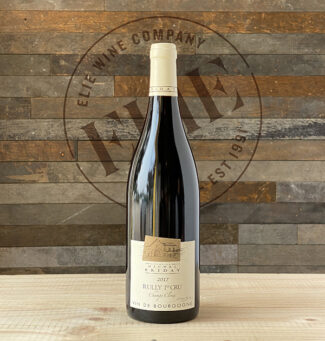 Rully Premier Cru – Champs Cloux 2017 (Red) ($39) is, quite literally, the fruit of the Bridays’ labor, dominated by aromas of blackberries, violets and spices above complex notes of leather, fur, and undergrowth. This is a well-structured wine combining both power and finesse.
Rully Premier Cru – Champs Cloux 2017 (Red) ($39) is, quite literally, the fruit of the Bridays’ labor, dominated by aromas of blackberries, violets and spices above complex notes of leather, fur, and undergrowth. This is a well-structured wine combining both power and finesse.
Givry
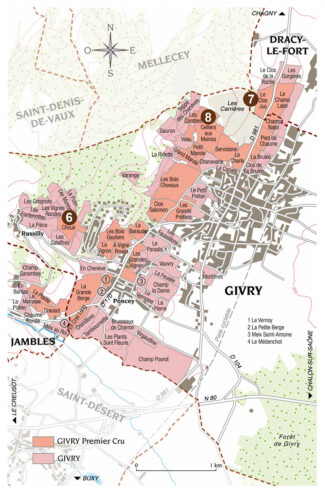 Givry sits at the heart of the Chalonnaise, so it’s fitting that its pulse pumps mostly red wine; the limestone-rich slopes to the west of Givry village—with soil exposed by numerous quarries—are predominately planted to Pinot Noir and contain a remarkable number of first growth sites. Within the appellation are 27 individual Premier Crus representing around a sixth of its 541 acres. Yet, another face exists: Although it accounts for a much smaller proportion of Givry’s output, Chardonnay-based whites, generally planted on clay soils, are renowned for spicy sophistication, often with subtle notes of anise and saline.
Givry sits at the heart of the Chalonnaise, so it’s fitting that its pulse pumps mostly red wine; the limestone-rich slopes to the west of Givry village—with soil exposed by numerous quarries—are predominately planted to Pinot Noir and contain a remarkable number of first growth sites. Within the appellation are 27 individual Premier Crus representing around a sixth of its 541 acres. Yet, another face exists: Although it accounts for a much smaller proportion of Givry’s output, Chardonnay-based whites, generally planted on clay soils, are renowned for spicy sophistication, often with subtle notes of anise and saline.
6- Domaine François Lumpp
In Burgundy, finding an old-school vigneron who plants and nurtures his own vines is increasingly difficult. François Lumpp is one such winemaker. Having launched his own label in 1991 with cuttings from older bud wood, his domain’s focus is on Premier Cru climats within Givry—he is entirely a man of the appellation.
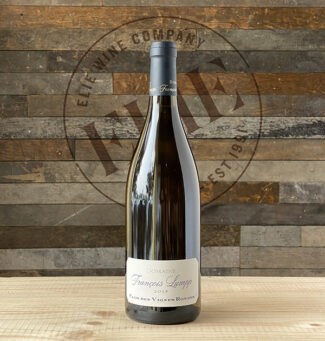 Givry ‘Clos des Vignes Rondes’ 2015 (White) ($39)comes from an acre-and-half late-ripening hillside parcel over a thousand feet above sea level and displays lovely aromas of apple peel, damp pavement, citrus and butterscotch and flavors that echo the nose. Length is remarkable and the acidity succulent; the wine is mature, but may continue to improve.
Givry ‘Clos des Vignes Rondes’ 2015 (White) ($39)comes from an acre-and-half late-ripening hillside parcel over a thousand feet above sea level and displays lovely aromas of apple peel, damp pavement, citrus and butterscotch and flavors that echo the nose. Length is remarkable and the acidity succulent; the wine is mature, but may continue to improve.
7- Domaine Ragot
By the time Louis Ragot established vines in Givry in the middle of the eighteenth century, his family had already been Burgundian farmers for a century. His domain, once called Ragot Frères, became Domaine Ragot when cousins Jean-Paul and Jean-Pierre Ragot took over. Despite the new name, adherence to tradition remains paramount: All the fruit is hand-harvested and the clusters manually destemmed. Only indigenous yeasts are used, which preserves the integrity of the vineyard’s character.
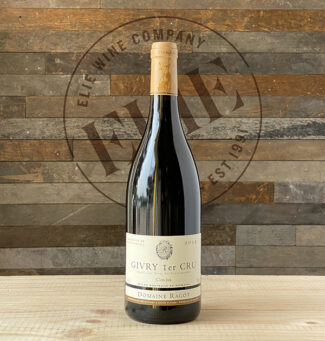 Givry Premier Cru – Clos Jus 2014 (Red) ($39) comes from an East-facing two-acre site at the top end of Givry where red clay soils produce a wine that is expressive and bright and shows black cherry and raspberry up front, a slightly earthy undertone with moderate spice at the finish, mostly cinnamon and cola.
Givry Premier Cru – Clos Jus 2014 (Red) ($39) comes from an East-facing two-acre site at the top end of Givry where red clay soils produce a wine that is expressive and bright and shows black cherry and raspberry up front, a slightly earthy undertone with moderate spice at the finish, mostly cinnamon and cola.
This 7-pack contains one bottle of each of the above featured wines at a price of $299, tax included. We are offering the following wine, in magnum, for a special price to add to the purchase.
Special Price for Special Bottle. En Magnum.
8- Domaine du Cellier aux Moines, Givry ‘Clos Pascal – Monopole’ 2017, 1500 ML $450:
Overlooking one of Givry’s historic Premier Crus, the Cellier aux Moines (magnificently restored by Catherine and Philippe Pascal), Clos Pascal was recovered and planted to Pinot Noir in 2010. With a scant two-thirds of an acre, the south-facing vines, at high density of 5300 vines per acre, are tressed rather than hedged and tended using sustainable agriculture.
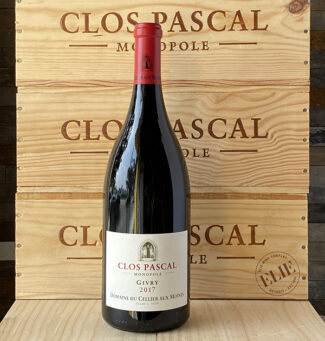 The wine itself is luxurious; fine lace and silk suspended within a bottle. The intensity of the garnet color is matched by the complexity of the aromas, evoking violets, tart cherry conserve and damp forest floor. There is vibrant tension between texture and acidity. Long aftertaste, with dusty tannins and notes candied Morello cherry.
The wine itself is luxurious; fine lace and silk suspended within a bottle. The intensity of the garnet color is matched by the complexity of the aromas, evoking violets, tart cherry conserve and damp forest floor. There is vibrant tension between texture and acidity. Long aftertaste, with dusty tannins and notes candied Morello cherry.
This is a ‘vin de garde’—a wine meant for aging. As such, a magnum is the ideal size since during the aging process, twice as much wine is exposed to the same amount of air, keeping the wine fresher as it develops complexity through the years.
A note on vintages: Nowhere in France is vintage more important than in Burgundy, and this package contains gems from several different harvests. A brief overview of growing conditions in the Côte Chalonnaise during the vintages offered in the package is as follows:
2014: A warm, dry spring led to early bud break, but in late June, hailstorms decimated some vineyards in the north, causing reduced yields and (a silver lining), more highly concentrated wines. A drying wind and a sunny September made this vintage especially friendly to Chardonnay.
2015: An ideal growing season until excessive July heat began to pose some problems, which were eased by intermittent rains in August. Results were excellent overall with lush, ripe, broad-beamed wines produced in most Premier Cru sites.
2017: Considered a very fine vintage in the Côte Chalonnaise with excellent yields. Noted differences between wines from north and wines from the south are stylistic rather than in quality, which remains high. Wines from the north are nicely scented with a sensational balance of fruit and acid while those from the south are juicy, rich and indulgent.
2018: In general, 2018 was a heatwave year; grapes flowered in May, and the summer was long, dry and record-breaking hot. Yet even the growers were surprised at the brightness the harvest yielded; common descriptors for the Chardonnays are “great tension and freshness’ and for the Pinot Noirs “vivid with expressive fruit and richness.”
- - -
Posted on 2021.07.22 in Monatgny, Givry, Côte Chalonnaise, Bouzeron, Mercurey, Rully, France, Burgundy, Wine-Aid Packages
Featured Wines
- Notebook: A’Boudt Town
- Saturday Sips Wines
- Saturday Sips Review Club
- The Champagne Society
- Wine-Aid Packages
Wine Regions
Grape Varieties
Aglianico, Albarino, Albarín Blanco, Albarín Tinto, Albillo, Aleatico, Arbanne, Aubun, Barbarossa, barbera, Beaune, Biancu Gentile, bourboulenc, Cabernet Franc, Cabernet Sauvignon, Caino, Caladoc, Calvi, Carcajolu-Neru, Carignan, Chablis, Chardonnay, Chasselas, Clairette, Corvina, Cot, Counoise, Erbamat, Ferrol, Fiano, Frappato, Friulano, Fromenteau, Fumin, Garnacha, Gewurztraminer, Godello, Graciano, Grenache, Grolleau, Groppello, Juan Garcia, Lambrusco, Loureira, Macabeo, Macabou, Malvasia, Malvasia Nera, Marsanne, Marselan, Marzemino, Melon de Bourgogne, Merlot, Mondeuse, Montanaccia, Montepulciano, Morescola, Morescono, Moscatell, Muscadelle, Muscat, Natural, Nero d'Avola, Parellada, Patrimonio, Petit Meslier, Petit Verdot, Pineau d'Aunis, Pinot Auxerrois, Pinot Blanc, Pinot Gris, Pinot Meunier, Pinot Noir, Poulsard, Prieto Picudo, Rondinella, Rousanne, Roussanne, Sangiovese, Sauvignon Blanc, Savignin, Semillon, Souson, Sparkling, Sumoll, Sylvaner, Syrah, Tannat, Tempranillo, Trebbiano, Trebbiano Valtenesi, Treixadura, Trousseau, Ugni Blanc, vaccarèse, Verdicchio, Vermentino, Viognier, Viura, Xarel-loWines & Events by Date
- April 2024
- March 2024
- February 2024
- January 2024
- December 2023
- November 2023
- October 2023
- September 2023
- August 2023
- July 2023
- June 2023
- May 2023
- April 2023
- March 2023
- February 2023
- January 2023
- December 2022
- November 2022
- October 2022
- September 2022
- August 2022
- July 2022
- June 2022
- May 2022
- April 2022
- March 2022
- February 2022
- January 2022
- December 2021
- November 2021
- October 2021
- September 2021
- August 2021
- July 2021
- June 2021
- May 2021
- April 2021
- March 2021
- February 2021
- January 2021
- December 2020
- November 2020
- October 2020
- September 2020
- August 2020
- July 2020
- June 2020
- May 2020
- April 2020
- March 2020
- February 2020
- January 2020
- December 2019
- November 2019
- October 2019
- September 2019
- August 2019
- July 2019
- June 2019
- May 2019
- April 2019
- March 2019
- February 2019
- January 2019
- December 2018
- November 2018
- October 2018
- September 2018
- August 2018
- July 2018
- June 2018
- May 2018
- April 2018
- March 2018
- February 2018
- January 2018
- December 2017
- November 2017
- October 2017
- September 2017
- August 2017
- July 2017
- June 2017
- May 2017
- April 2017
- March 2017
- February 2017
- January 2017
- December 2016
- November 2016
- October 2016
- September 2016
- August 2016
- July 2016
- June 2016
- May 2016
- April 2016
- March 2016
- February 2016
- January 2016
- December 2015
- November 2015
- October 2015
- September 2015
- August 2015
- July 2015
- June 2015
- May 2015
- April 2015
- March 2015
- February 2015
- January 2015
- December 2014
- November 2014
- October 2014
- September 2014
- August 2014
- July 2014
- June 2014
- April 2014
- March 2014
- February 2014
- January 2014
- December 2013
- November 2013
- October 2013
- September 2013
- August 2013
- July 2013
- June 2013
- May 2013
- April 2013
- March 2013
- February 2013
- January 2013
- December 2012
- November 2012
- October 2012
- February 2004
Search



